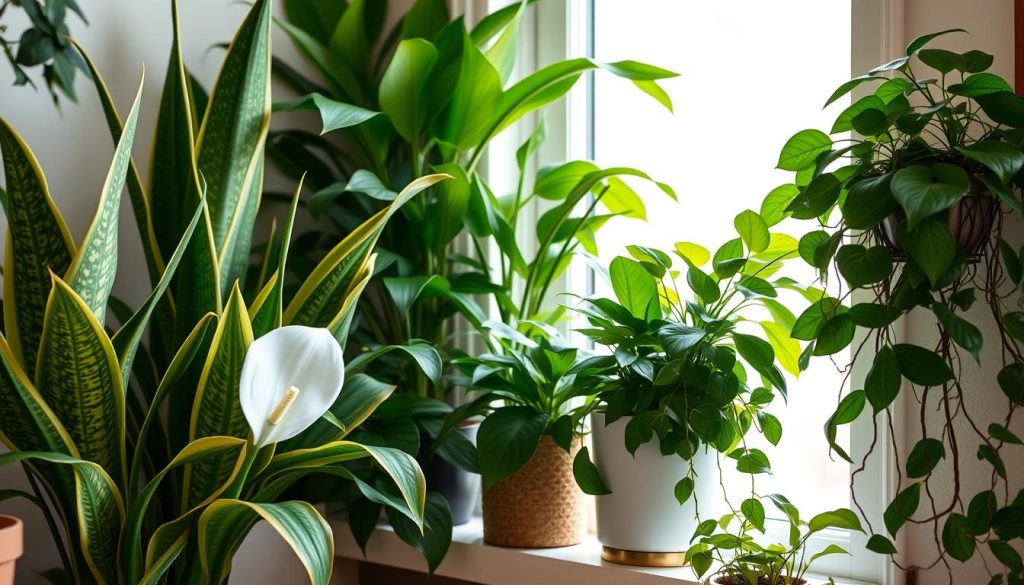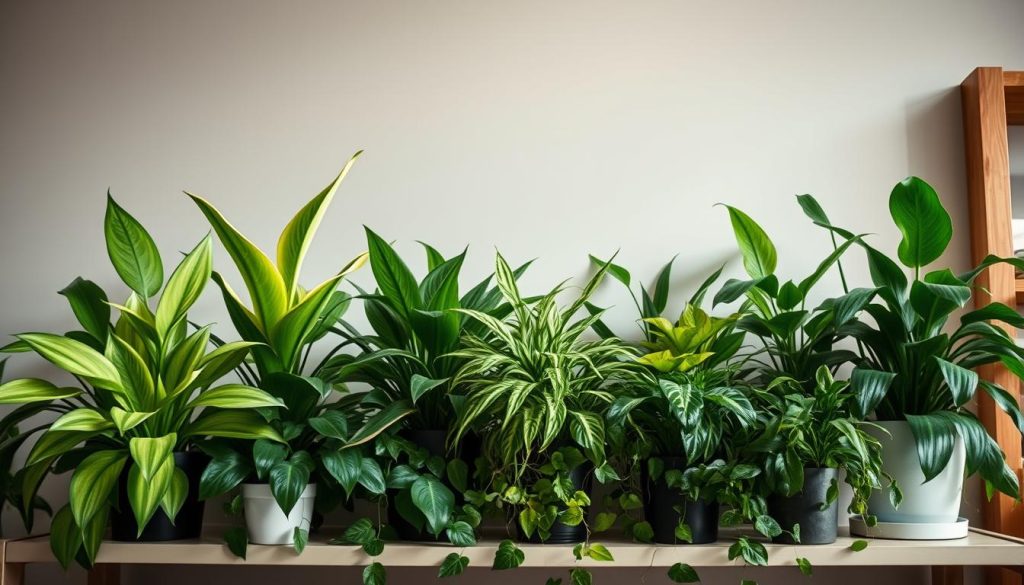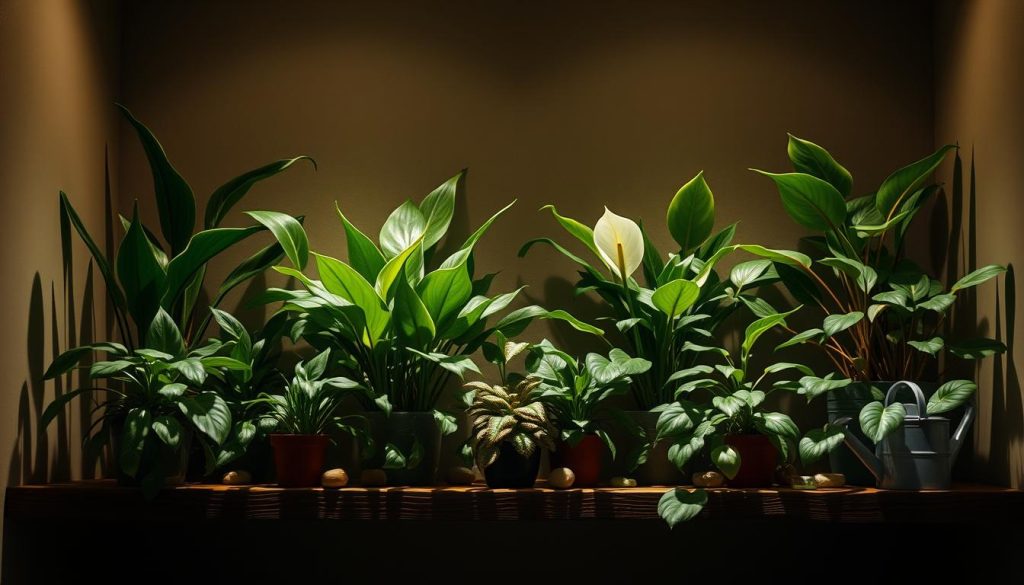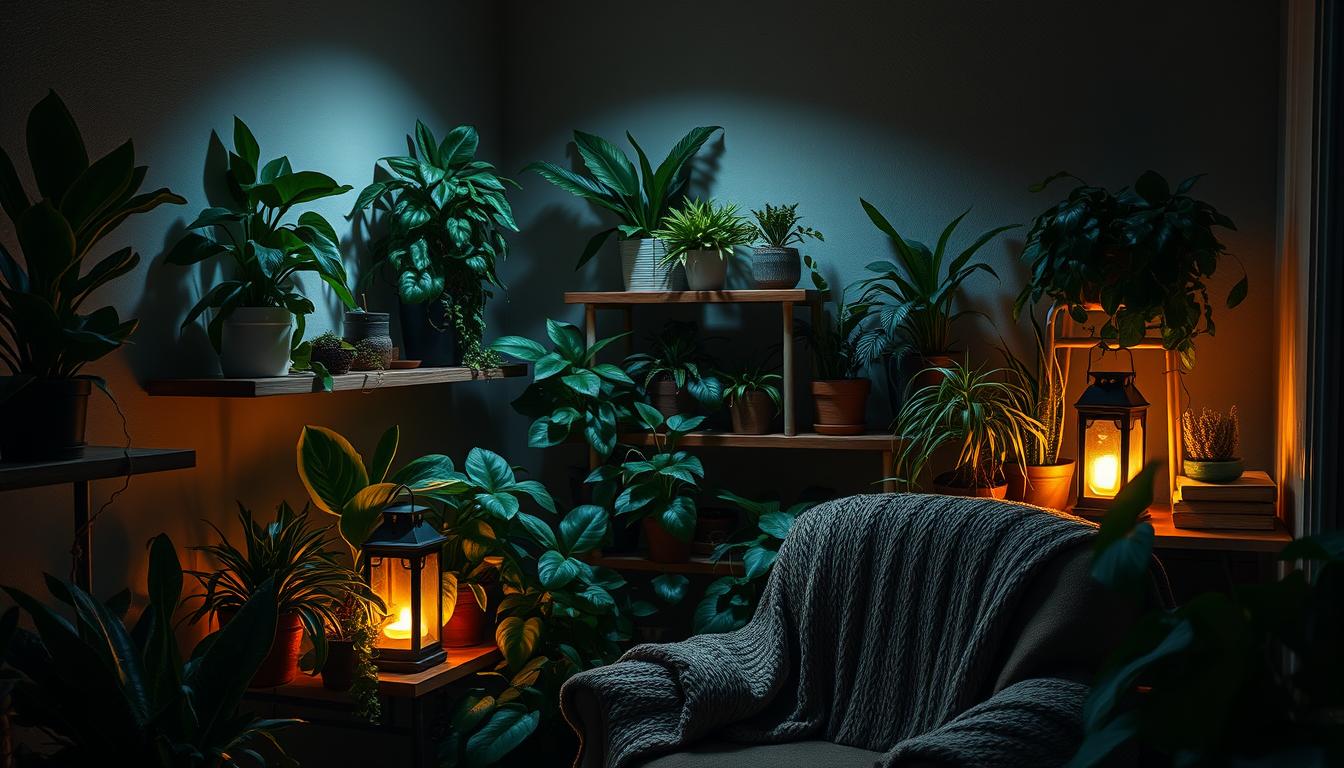I’m excited to share my experience with low-light indoor plants. They’ve brought a lot of joy to my life. I used to struggle with keeping plants alive, but I’ve learned a lot.
Choosing the right plants for low light is key. I’ve found that even the darkest spots in my home can support these plants. I’m eager to share my tips on how to keep them healthy.
Low-light indoor plants are a big part of my home now. They purify the air and add greenery to my decor. With the right care, even delicate plants can thrive. I’m excited to share my knowledge with other plant lovers.
In this article, I’ll share my personal experience and tips. I’ll cover everything from choosing the best plants for beginners to expert care. Whether you’re new to plants or a seasoned enthusiast, I hope to inspire and educate you.
Why I Love Low-Light Indoor Plants
I’ve always been drawn to the beauty and benefits of indoor plants, especially those that grow well in low light. Having these plants at home has changed my life. They add greenery, purify the air, and reduce stress. Plus, they thrive in spots with little natural light, making them ideal for rooms with few windows or during winter.
Some of the benefits of having low-light indoor plants include:
- Air purification: They remove toxins and pollutants, making the air healthier.
- Stress relief: Caring for plants can lower stress and anxiety, promoting calm and well-being.
- Aesthetic appeal: Low-light indoor flowers and plants bring natural beauty to my home, making it cozy and inviting.
I enjoy taking care of my indoor plants and appreciate how they can grow in low light. Whether it’s a low-light tolerant plant or a beautiful indoor flower, I love having them around. 
Benefits of Low-Light Plants
Low-light plants are perfect for indoor spaces because they can tolerate low light and offer many benefits. They purify the air, reduce stress, and add beauty to any home.
Aesthetic Appeal of Greenery
The beauty of greenery is undeniable, and low-light indoor plants are no exception. They bring natural beauty to my home, creating a cozy and inviting atmosphere that I love.
Stress Relief Through Plant Care
Caring for my indoor plants helps me reduce stress and anxiety. The simple tasks of watering, pruning, and nurturing them promote calm and well-being. It’s an essential part of my self-care routine.
The Best Low-Light Indoor Plants for Beginners
Choosing the right plants is key for beginners. You want plants that are easy to care for and do well in low light. There are many low maintenance low light plants that are perfect for adding greenery to your home.
Some top picks for beginners include:
- Snake Plant: known for its ability to purify the air and thrive in low-light conditions
- Pothos: a low-maintenance plant that can grow in a variety of lighting conditions
- ZZ Plant: a low-maintenance plant that can tolerate low light and infrequent watering
These plants are not only beautiful but also great for air purification. They help create a calming atmosphere in your home. By picking the right plants, you can enjoy indoor plants without the stress of caring for them.

With a little research and planning, you can find the perfect plants for your home. Whether you’re looking for something easy to care for or a plant that does well in low light, there’s a plant for you.
My Top Tips for Keeping Low-Light Plants Healthy
To keep my low-light indoor plants healthy, I water them wisely. I also make sure they get the right amount of light and fertilize them regularly. This is crucial for plants that do well in low light. By following these tips, your plants will thrive in low-light conditions.
Some key considerations for keeping low-light indoor plants healthy include:
- Watering wisely: Overwatering can harm low-light indoor plants. It’s important to check the soil moisture before watering.
- Providing the right amount of light: Low-light plants still benefit from some indirect sunlight. Placing them near a window with a sheer curtain is helpful.
- Fertilizing regularly: Using a balanced fertilizer promotes healthy growth and development in low-light indoor plants.
By following these tips, you can help your low-light indoor plants stay healthy and thrive. Always research the specific care needs of your plants. Some may have unique requirements.

Understanding the Unique Needs of Low-Light Plants
To keep my low-light indoor plants happy, I need to understand their unique needs. Low light plants require specific care to thrive. It’s essential to provide them with the right conditions.
Choosing the right soil types for my houseplants for low light is crucial. The soil should be well-draining to prevent waterlogged soil, which can lead to root rot.
Maintaining optimal humidity levels is another vital factor. Low-light plants prefer a humid environment, typically between 40-60% relative humidity. To achieve this, I can use a humidifier or group my plants together to create a microclimate.
Here are some tips for maintaining the right humidity levels for my low-light plants:
- Use a humidifier to maintain a consistent humidity level
- Group plants together to create a microclimate
- Avoid placing plants near heating or cooling vents
By understanding the unique needs of my low-light plants, including soil types and humidity levels, I can provide them with the best possible care. This will help my houseplants for low light thrive and bring joy and beauty to my indoor space.

| Soil Type | Humidity Level | Plant Care Tips |
|---|---|---|
| Well-draining soil | 40-60% relative humidity | Water carefully, avoid overwatering |
| Moisture-retentive soil | 50-70% relative humidity | Fertilize regularly, prune as needed |
Common Mistakes in Low-Light Plant Care
I love low maintenance low light plants, but I’ve learned to avoid common mistakes. It’s important to focus on key areas to ensure my plants get the best care. This way, they can thrive in low light conditions.
Understanding the unique needs of these plants is crucial. I avoid overwatering and neglecting fertilization. Regular soil moisture checks and fertilizing during the growing season help a lot.
- Overwatering, which can lead to root rot and other problems
- Neglecting fertilization, which can result in weak and spindly growth
- Not providing enough humidity, which can cause leaf drop and other issues
Knowing these common mistakes helps me prevent them. This way, my low maintenance low light plants can flourish in indoor plants low light conditions.
| Mistake | Prevention |
|---|---|
| Overwatering | Check soil moisture regularly |
| Neglecting fertilization | Fertilize during the growing season |
| Not providing enough humidity | Use a humidifier or group plants together |
By following these tips, I can enjoy the beauty and air-purifying benefits of low maintenance low light plants. They add beauty to my space, even in low light conditions.
How I Combat Pests on Indoor Plants
To keep my low-light indoor plants healthy, I must watch out for pests. Pests can harm plants that grow well in low light. It’s important to spot infestations early.
Pests like spider mites, mealybugs, and scale can harm my plants. They can cause yellow leaves, slow growth, and even kill the plant. I use natural ways to fight these pests, keeping my plants and the environment safe.
Recognizing Pest Infestations
Spotting pests is key to protecting my plants. I check my plants often for pests. Signs include white patches, sticky leaves, or actual pests.
If I see any signs, I act fast to stop the problem from getting worse.
Natural Pest Control Methods
I use natural methods to fight pests on my plants. These include:
- Neem oil: a natural insecticide for many pests
- Soap solution: a mild dish soap kills pests on contact
- Pruning: removing infested parts stops pests from spreading
These natural methods help keep my plants healthy and pest-free. Regular checks and quick action are crucial to keep pests away and ensure my plants thrive in low light.
| Pest | Signs of Infestation | Natural Pest Control Method |
|---|---|---|
| Spider Mites | Yellowing leaves, fine webbing | Neem oil, soap solution |
| Mealybugs | White powdery patches, sticky substance | Neem oil, pruning |
| Scale | Brown or black bumps on leaves or stems | Neem oil, soap solution |
Seasonal Care Tips for Low-Light Plants
To keep my low-light indoor plants happy all year, I change how I care for them with the seasons. I learn what each plant needs at different times. For example, they need less water in winter when they’re sleeping.
Some important things to think about for seasonal care are:
- Adjusting watering schedules to prevent overwatering during winter
- Providing adequate nutrients to support growth patterns in spring
- Monitoring temperature and humidity levels to create an optimal environment for houseplants for low light
By considering these points, I give my low-light plants the best care. This helps them not just survive but also grow well in low light. Whether you’re new to plants or have been caring for them for years, knowing how to care for them seasonally is key.
As I care for my plants, I’ve learned how crucial it is to adjust to the seasons. This way, I create a perfect spot for them to grow, even with little natural light. This has deepened my bond with my plants and made me appreciate their special traits.
My Favorite Sources for Plant Care Advice
I love plants and always seek new ways to care for them, especially in low light. I find the best tips and tricks online and in books. This helps me keep my indoor plants happy and healthy.
Trusted Online Resources
Here are some websites I always check:
- The Spruce, a treasure trove of plant care info
- Houseplant Journal, great for tips on low light plants
- Gardening Know How, a vast library of gardening guides
Books I Recommend
Books are also a big help for me:
- “The Houseplant Bible” by Lisa Eldred Steinkopf, a detailed guide
- “Low-Light Plants” by Nedra Secrist, perfect for low light care
Building My Low-Light Indoor Plant Collection
I love growing low-light indoor plants and enjoy adding new ones to my collection. Finding the right plants is a fun journey. I’m always looking for new additions to my green family.
Where to Buy Low-Light Plants
It’s important to know where to buy low-light plants. I’ve found great plants at local nurseries, home improvement stores, and online. Researching reputable sources helps keep my plants healthy and long-lasting.
Expanding My Plant Family Over Time
I’ve been adding new plants to my collection slowly. I make sure each plant fits well with the others. Learning about each plant’s needs helps me create a peaceful indoor space. I’m always excited to welcome new plants to my family.

